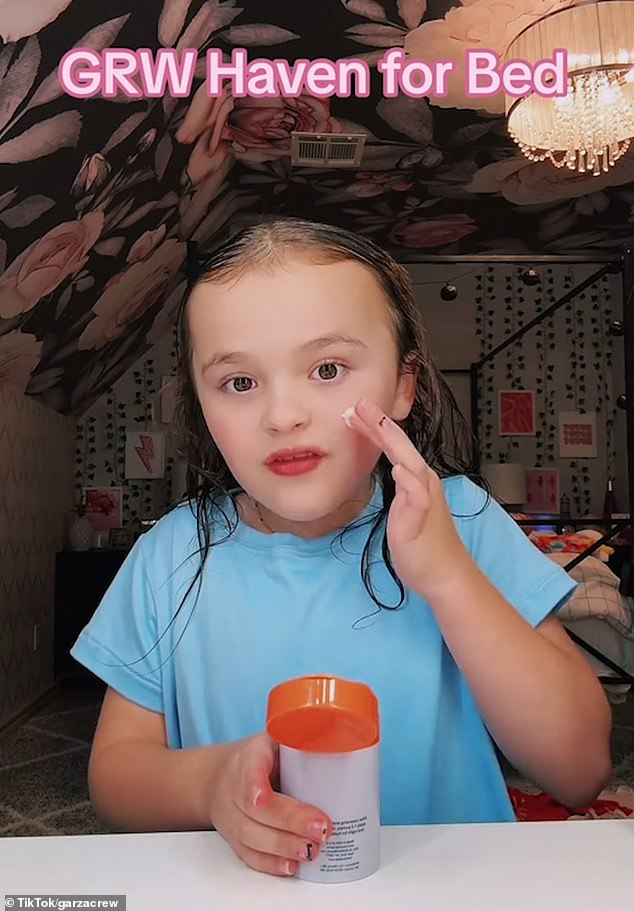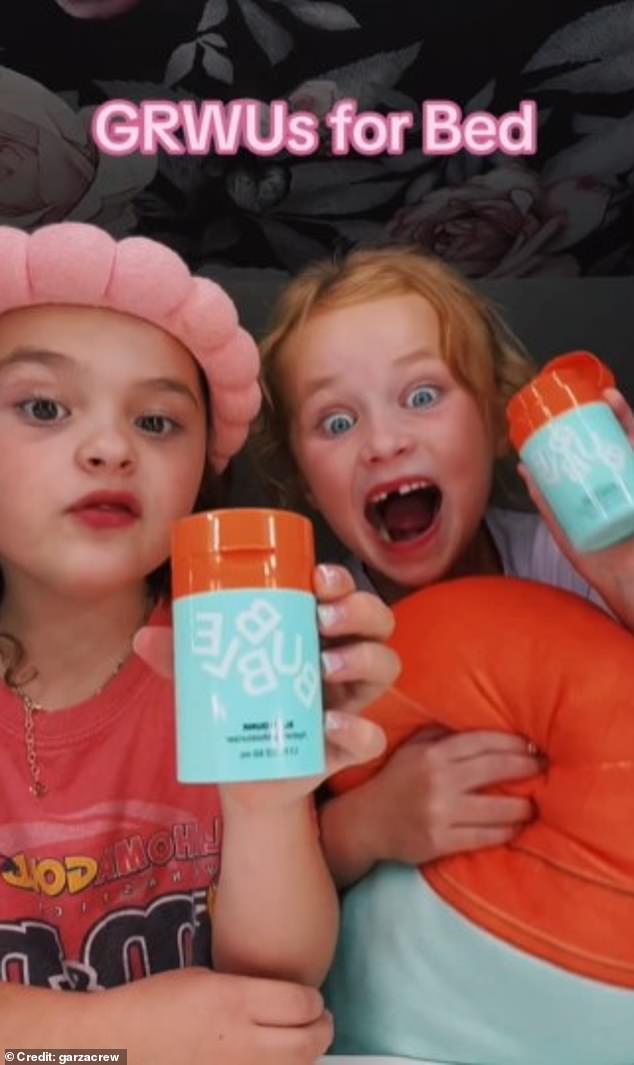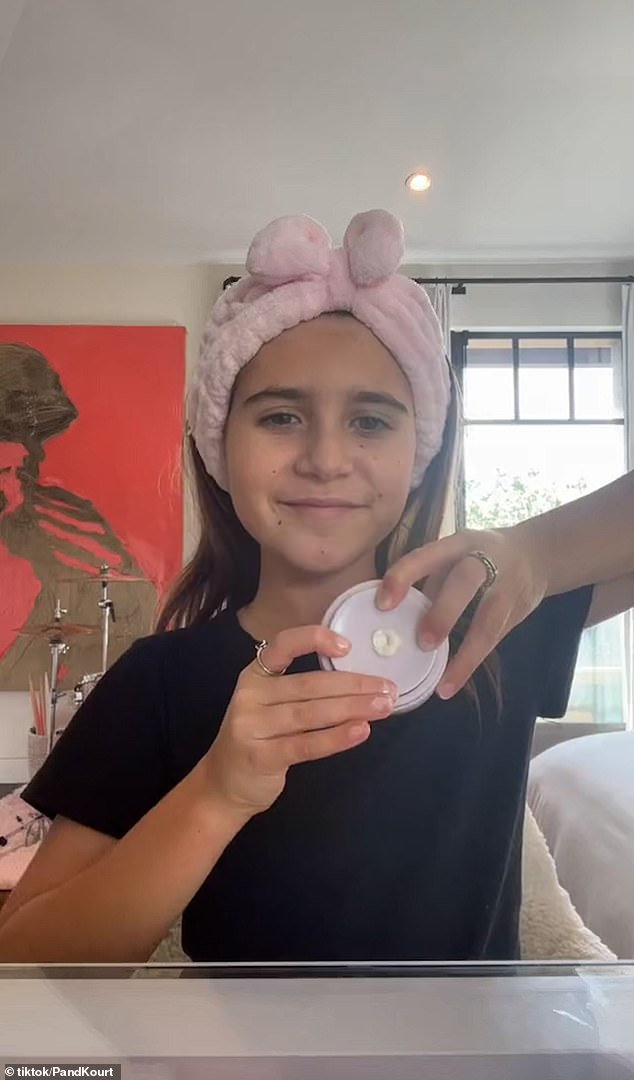The ‘get ready with me’ video is one of the most popular formats for TikTok influencers to show off their elaborate beauty regimes.
Children dubbed ‘Sephora kids’ are getting involved in the trend, with terrifying consequences.
Scientists from Northwestern University found that children as young as seven are using over a dozen products on their skin every day.
These expensive routines are putting children at risk of skin irritation, sun sensitivity, and developing lifelong skin allergies.
By creating dummy accounts posing as 13-year-olds the researchers collected 100 videos from the TikTok ‘For You Page’.
On average, girls aged between seven and 18 used six different skin care products in their routines, with some using far more.
The survey also revealed the vast sums of money that youngsters are willing to spend on products.
Teenagers’ routines cost an average of $168 (£124) with some girls using products that cost over $500 (£370) in total.

Skincare routines are one of the biggest trends on TikTok, but scientists have now warned that they could be far more harmful than young users realise
Searching for ‘skin care’ or ‘skin care routine’ on TikTok will return thousands of videos, many of which have hundreds of thousands or even millions of likes.
These videos largely feature young women showing their complicated, multi-step skincare routines.
For example, one video with over 4.1 million likes recommends a routine of six different treatments including Vitamin C cream, hyaluronic acid, and ‘chemical exfoliants’.
Yet the study found that many younger users on the app were showcasing routines with even more steps.
While these routines promised to deliver ‘glassy’ or ‘glowy’ skin, the researchers found that they actually put teenagers at high risk of skin irritation.
The top-viewed videos analysed by the researchers contained an average of 11 potentially irritating ingredients.
Corresponding author Dr Molly Hales, a dermatologist at Northwestern University, says: ‘That high risk of irritation came from both using multiple active ingredients at the same time, such as hydroxy acids.
Those ingredients could trigger an allergic condition called contact dermatitis which can limit the kinds of soaps and shampoos that people can use for the rest of their lives.

TikTok users between seven and eighteen used an average of six different skincare products in their videos, with some using more than a dozen

Some routines shared on TikTok involved up to 15 different stages and cost hundreds of pounds
Dr Hales adds that there was also a risk from ‘applying the same active ingredient unknowingly over and over again when that active ingredient was found in three, four, five different products.’
However, the video creators appeared either unaware of the risks or unconcerned by the potential negative impacts.
For example, in one video a young social media user applied 10 different products to her face in six minutes.
Senior author Dr Tara Lagu, a pharmacist and health services researcher from Northwestern University, says: ‘As she’s applying the products, she begins to express discomfort and burning, and in the final few minutes, she develops a visible skin reaction.’
In another post, a ‘teenage girl in braces’ smeared 14 products on her face while instructing her viewers on the proper methods of application.
By the end of the video, the girl’s face becomes visibly inflamed and red as she says: ‘This is what my skin looks like. It is very glowy right now, I love it! But also, I just had some allergic reaction to something that I tried, so ignore how red my face is.
‘I don’t know what’s happening. But if anybody knows how to get it to stop burning, that would be greatly appreciated, because it actually hurts a lot.’
Additionally, the researchers found that the advice in these videos offered ‘little to no benefit’ to their intended audience.

Researchers warn that using so many products risks causing skin irritation and developing skin allergies which can affect people for the rest of their lives
For example, each of the top 25 most-viewed videos used an average of three products containing natural exfoliants called Alpha Hydroxy Acids (AHAs).
While these can be used to treat acne, only eight of the 82 content creators had any visible blemishes.
In these cases, the risk of developing contact dermatitis ‘almost certainly’ outweighs any potential benefits.
In fact, only 26 per cent of the routines shown included suncream – which dermatologists say is the most useful part of any skin care routine and is especially important for children.
Beyond simply giving bad skin care advice, the researchers also cautioned that these videos could be ‘problematic’ in other ways.
Analysis of the videos showed a strong emphasis on lighter, brighter skin which could reinforce unattainable beauty standards.
In the paper, published in Pediatrics, the researchers note that the videos encourage girls to pursue these goals under the guise of ‘self-care’.

Videos analysed revealed that the average routine contained products worth $168 (£124) with some girls using products that cost over $500 (£370) in total
Girls are shown waking up as early as 04:30 am in order to fit in an elaborate skin care and makeup routine before school.
Dr Hales says: ‘The insidious thing about ‘skin care’ is that it claims to be about health.
‘It’s problematic to show girls devoting this much time and attention to their skin. We’re setting a very high standard for these girls.
‘The pursuit of health has become a kind of virtue in our society, but the ideal of “health” is also very wrapped up in ideals of beauty, thinness and whiteness.’
